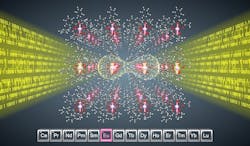Light from rare-earth ions shows promise for quantum computers and networks
A team of Chimie ParisTech, CNRS, Strasbourg University, and Karlsruhe Institute of Technology researchers in France and Germany discovered a novel material for processing quantum information with light: a europium molecular crystal, which contains nuclear spins that can be quantum-mechanically entangled.
Europium is a rare-earth metal, known for being the most reactive member of the lanthanide series of the periodic table (63). Rare-earth molecular crystals are intriguing to researchers because they can be chemically engineered with atomic precision.
“It means we can choose the material composition and exact arrangement of atoms surrounding the rare-earth ion,” says Diana Serrano, a CNRS researcher. “This opens the door to fine-tuning rare-earth ion properties.”
And europium exhibits luminescence via laser excitation, emitting photons carrying nuclear-spin information. Nuclear spins—angular momentum of atomic nuclei—within molecules enable superposition states with long coherence lifetimes, because nuclear spins are shielded from the environment and protect quantum bits (qubits) from external impacts.
Quantum operations require numerous qubits entangled by quantum mechanics, and the team’s work shows europium ions within molecules can couple via electrical stray fields—enabling future entanglement and quantum information processing.
Their work also covers the addressing of nuclear-spin levels with the help of photons, coherent storage of photons, and quantum operations.
Optical addressing, coherent storage of photons, quantum operations
Optical addressing increases the readout speed and can be used to prevent interfering electrical feeds, according to the team. Compared to previous projects, they report a 1000x optical-coherence improvement in a molecular material—thanks to nuclear-spin states being manipulated optically in a specific way.
The main optics of this work involve the storage of an optical coherent state from a laser pulse into an atomic transition—in this case, from europium ions. “This optical-coherent state becomes a quantum superposition between the ground and excited states of the europium transition,” Serrano explains.
Once the superposition state is created, it can be recovered in the form of a light pulse emitted by the material that carries the information of the initial input pulse (see figure). “This is how optical quantum memories work,” Serrano says. “And from this storage-recovery process, we can extract information about the quantum storage time or efficiency.”
One of the biggest challenges designing good quantum materials is the need for long-term storage combined with a high density of qubits and strong interactions between them.
In practice, it’s “very difficult to do this within a single system because strong interactions tend to be detrimental for the storage time,” says Serrano. “One of the coolest aspects of this material is it can have a very high density of qubits, all identical and in a well-defined position, while still maintaining long optical storage times. There is room for improvement and many other molecular compositions to test, but these materials look very promising.”
An important challenge for optical quantum technologies is to be able to address single rare- earth ions. “Europium has a very low emission rate, which has never been addressed and detected individually,” says Serrano. “The way to overcome this challenge is by coupling the optical transition with photonic structures or optical cavities, which enables enhancing the ion emission rate. This method has been successfully applied to erbium, another rare earth ion with a very low emission rate.”
The main applications the researchers are targeting now are quantum computing and quantum communications.
What’s next? Serrano sees a lot of room for improvement ahead and many other molecular compositions to synthesize and test.
“Exploring molecules containing other rare-earth ions than europium would be interesting,” she says, “because every rare earth within the lanthanide series presents different transition wavelengths and also different spin properties, another dimension important for quantum technologies because it allows for longer storage times. We also envision efficient coupling of the molecules to photonic structures.”

Sally Cole Johnson | Editor in Chief
Sally Cole Johnson, Laser Focus World’s editor in chief, is a science and technology journalist who specializes in physics and semiconductors.
